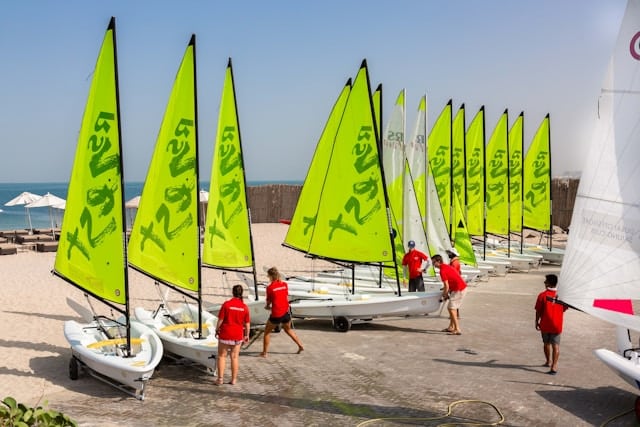How Can Real-Time Aerodynamic Feedback Devices Benefit Competitive Sailors?

Sailing is not just a leisure activity – it’s a sport that blends the elemental forces of wind and water with the technology of sailboats. A significant factor in a sailing race is the navigator’s ability to read and respond to the wind. In recent times, this elemental aspect of sailing has been on the receiving end of some cutting-edge technology. Real-time aerodynamic feedback devices are now being used to provide sailors with data on wind patterns and sail conditions, enabling them to make micro-adjustments for optimal performance. Let’s delve into this advanced technology and examine its implications for competitive sailing.
The Connection Between Sailing and Aerodynamics
The principle of sailing is deeply entwined with aerodynamics, the study of how air moves around objects. A sailboat is propelled forward by harnessing the wind’s force against its sails. The sail’s figure, its shape and orientation, can significantly influence the boat’s speed and maneuverability.
A lire en complément : What Is the Best Strategy to Enhance Concentration During Long Golf Tournaments?
The design of the sailboat, especially its hull, also plays a crucial role in overcoming water resistance. Naval architects spend considerable time and resources designing hulls that offer the least resistance to water and testing them under various conditions.
With the advent of real-time aerodynamic feedback devices, the process of sail adjustment and hull resistance management has become more scientific and precise. These devices collect data on wind speed and direction, sail shape, and boat speed, allowing sailors to adjust their sails and course for optimal performance.
Lire également : What’s the Role of Active Recovery Sessions in Preventing Overuse Injuries in Tennis Players?
The Rise of Robotic Assistance in Sailing
Robotic technology has been revolutionizing various fields, and sailing is no exception. The emergence of autonomous sailing robots has brought about significant changes in the way we approach sailing.
These robotic sailors, designed and tested by teams of engineers and naval architects, are capable of optimizing their course and sail orientation based on real-time aerodynamic feedback. In recent years, China has emerged at the forefront of this technology, with various research teams working on autonomous sailing robots.
The use of these robots is not limited to racing alone. The data collected during testing can also provide valuable insights into sail and hull design, leading to the development of more efficient and faster sailboats.
The Impact of Real-Time Aerodynamic Feedback Systems on Competitive Sailing
The introduction of real-time aerodynamic feedback devices has ushered in a new era of competitive sailing. These devices can provide sailors with critical information about the wind’s speed and direction, sail pressure, and boat speed.
With this data, sailors can adjust their course and sail conditions to adapt to the wind’s changing nature. This allows them to maximize their boat’s speed and maneuverability, giving them a competitive edge in races.
In addition to providing real-time feedback, these systems also allow sailors to analyze their performance post-race. They can review the data collected during the race to identify areas where they can improve their performance.
The Future of Aerodynamic Feedback Devices in Sailing
The future holds exciting potential for the integration of aerodynamics and sailing. As the technology behind real-time aerodynamic feedback devices continues to evolve, we can expect even more precise and actionable data to be available to sailors.
Emerging technologies such as machine learning and artificial intelligence can add a new dimension to these devices, enabling them to learn from past data and make more accurate predictions about future wind conditions.
In addition, the integration of these devices with autonomous sailing robots could revolutionize sailing races. Imagine a future where autonomous sailboats, guided by real-time aerodynamic data, compete in high-stakes races. These advancements could further elevate the skill level required in competitive sailing.
The advent of real-time aerodynamic feedback devices is an exciting development in the world of sailing. With their ability to provide critical data on wind and sail conditions, these devices are poised to have a profound impact on competitive sailing. As the technology continues to evolve, the future of sailing is looking increasingly high-tech and exciting.
Applications of Autonomous Sailing Robots in Modern Races
The use of autonomous sailing robots in the world of competitive sailing is not a futuristic concept, but a reality of today’s racing scene. A perfect illustration of this innovation was seen in the recent America Cup, where an autonomous sailboat created by the Chinese University of Hong Kong and Shenzhen, China, made its debut.
This robotic sailing marvel was designed to optimize its course and sail rudder based on real-time aerodynamic feedback. Equipped with sensors to detect wind speed and direction, the autonomous sailing robot navigated through knots of wind, adjusting its soft sail to maximize energy consumption and enhance boat speed.
The significant advantage of this sailing robot is its ability to make precise adjustments in real-time. As wind conditions change rapidly during a race, the ability to instantly adapt and optimize performance based on wind direction and speed can be the difference between victory and defeat.
One of the primary challenges in sailing is managing the boat’s energy consumption. In traditional sailing, a lot of energy is wasted due to suboptimal sail and rudder positions. However, with the integration of real-time aerodynamic feedback devices and autonomous sailing technology, this issue can be significantly mitigated.
As we continue to push the boundaries of science and engineering, the application of autonomous sailing robots will likely become more prevalent in competitive sailing. The long-term implications of this technology extend beyond just racing, opening up a world of possibilities for naval architecture and marine engineering.
Conclusion: A New Horizon for Sailing Technology
As the sailing world continues to embrace advanced technology, it’s clear that real-time aerodynamic feedback devices and autonomous sailing robots will play a significant role in shaping the future of the sport.
The collaboration between the Chinese University of Hong Kong and Shenzhen, China, has set a precedent, demonstrating the incredible potential of integrating autonomous sailing technology with real-time aerodynamic feedback systems. Their autonomous sailboat, which successfully navigated the challenging wind conditions of the America Cup, is a testament to the power of this technology.
In the not too distant future, we might see autonomous sailboats, guided by real-time aerodynamic data, not just competing but outperforming human sailors in high-stakes races. This prospect could transform competitive sailing, raising the bar for skill and precision to unprecedented levels.
The future of sailing is undoubtedly exciting. The rapid advancements in technology will continue to push the boundaries of what’s possible, making sailing not just a test of human skill and endurance but a showcase of cutting-edge technology and engineering prowess. As the saying goes, "A smooth sea never made a skilled sailor." By the same token, a world of predictable winds and calm seas would never have driven the innovations we’re now seeing in the sport of sailing.
